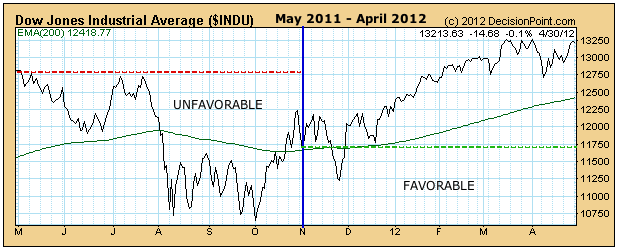May 1 marked the beginning of a 6-month period of unfavorable seasonality. Research published by Yale Hirsch in the Trader's Almanac shows that the market year is broken into two six-month seasonality periods. From May 1 through October 31 seasonality is unfavorable, and the market most often finishes lower than it was at the beginning of the period.
The period from November 1 through April 30 is seasonally favorable, and the market most often finishes the period higher. (See Sy Harding's book, Riding the Bear, for an indepth discussion of this subject.) While the statistical average results for these two periods are quite compelling, trying to ride the market in real-time in hopes of capturing these results is not always as easy as it sounds. Below is the one-year chart that that shows the most recent two six-month periods. It begins on May 1, 2011 and ends on April 30, 2012.
The left half of the chart shows the unfavorable May through October period and the right half shows the favorable November through April period. The green line marks the beginning of the favorable period, the red line marks the beginning of the unfavorable period.
As you can see, the last two seasonality periods turned in textbook performance, with the unfavorable period closing lower, and the favorable period closing higher. However, in the members area of the website we have a series of these charts going back to 1950 (when the seasonality tendency first appeared), and we can see that, regardless of how the market performs on average, every year is different and presents its own challenges, and there is no guarantee that any given period will conform to the average. In fact, it is our observation that bull and bear market pressures will override seasonal tendencies more often than not.
Conclusion: Be aware of current seasonal tendencies, but first and foremost follow the primary trend. Currently, we are in a bull market, but it appears to be forming a top, which coincides nicely with the change to unfavorable seasonality. This does not mean that the bull will not reassert itself, but seasonality will not be assisting the bull in that endeavor.







